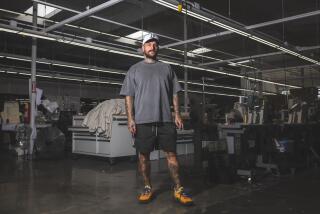Why do you need 1,000 sneakers? ‘Sneakerheadz’ tries to find out
Have you ever camped out overnight to buy a pair of kicks — or wondered why the heck anyone would? Then the new documentary “Sneakerheadz” is for you.
Directed by David T. Friendly (Academy Award-nominated producer of “Little Miss Sunshine”), the film -- which opens in limited release Friday -- looks into sneaker collecting from the Fairfax corridor in Los Angeles to the Ginza district in Tokyo. And it comes at a time when sneakers seem to be everywhere: on Paris fashion runways, Hollywood red carpets and at New York City’s Brooklyn Museum, where an exhibition on “The Rise of Sneaker Culture” is scheduled to run through Oct. 4.
While that exhibition is more about the history of sneakers, which have been around since the mid-19th century, the “Sneakerheadz” film explores the phenomenon of sneaker mania. “I wanted to identify the subculture and educate people who don’t know anything about it, while making a film that would appeal to real aficionados,” says Friendly, who stumbled onto his subject matter at a sneaker store in New York City in 2006 in the form of a retro (as in reissued) pair of chocolate brown Run DMC Adidas Superstars. Now he has more than 100 pairs in his personal collection.
------------
For the Record
Aug. 14, 11:52 a.m.: An earlier version of this post said sneakers have been around since 1917. Their origins date to the mid-19th century.
------------
He traces the defining moment of sneaker collecting to the mid-1980s when the worlds of sports, hip-hop and fashion first collided in pop culture. The first Air Jordan (named after basketball great Michael Jordan) was released by Nike in 1984, kicking off one of the most successful shoe sub-brands in history. Two years later Run DMC released the hit “My Adidas,” immortalizing their shoes in song, in a move that led the hip-hop group to collaborate with the shoe company on a signature Adidas Superstar style.
Collecting became big, with the idea of buying “one to stock and one to rock,” explains Roman Gratteri of Portland in the film. “It’s a game. Part of what this is is about who’s up the earliest and who’s the fastest.”
Before the Internet, you had to know someone to hear about new releases and travel to different cities to find exclusive styles. But auction sites like EBay took sneaker collecting from a regional subculture to an international marketplace. “Now with the Internet, with reselling, for the right price, you can get any shoe you want,” the film’s narrator DJ Skee explains.
“Sneakerheadz” features an all-star cast of footwear fanatics from around the globe, united by the desire to buy and wear the hardest-to-find, limited-edition styles, a pursuit which has often led to careers designing, selling or reselling — what else? — sneakers.
There’s Kansas City Royals baseball pitcher Jeremy Guthrie, who is so protective of his Air Jordans that he stores them in an at-home vault. “For me, it started as looking up to Michael Jordan as an athlete,” he says.
As brand manager of the Concepts streetwear store in Boston, Frank “the Butcher” Rivera partnered with Nike, Adidas and New Balance on numerous limited edition styles. He speaks poignantly of how his lifelong obsession resonates with his blue-collar roots: “Me taking home that shoe signified that things were going to be better.”
So-called sneaker pimp Andre “Dre” Ljustina founded online sneaker retail and resale site Project Blitz after amassing his own collection of 2,500 pairs, which he keeps in a spare room at his parents’ Hawthorne, Calif. home. And Tokyo-based Katsushige Kamamoto went from being homeless to owning the most prestigious sneaker resale destinations in Japan, the four Skit boutiques. With an inventory of 50,000 pairs, he makes a business of appraising and reselling collections, some of which arrive by the truckload. The biggest haul he’s ever nabbed was 800 pairs for $58,000.
In the 1990s, mainstream brands including Nike, Adidas and Reebok began collaborating with graphic designers, graffiti artists and eventually specialty retailers on models released in limited editions, creating another opportunity for collectors and resellers.
In 2005, the frenzy reached a new level when Nike tapped New York graphic designer/streetwear pioneer Jeff Staple to design the Pigeon Dunk DB as part of the Art of the Dunk series of limited edition styles launched in different cities. Kids camped out several nights in the February cold in front of Staple’s streetwear store Reed Space, the only retailer of the pigeon-gray, low-top shoes (original price $69.95, resale price $1,000). When the scene turned violent (some shoppers wielded knives and baseball bats), the police came, arrests followed, and sneaker mania became front page news. Today, Nike has hundreds of employees devoted to the business of launching original collaborations, which land as often as every few weeks, according to the film.
More recently, social media has fueled the collecting fire, with people posting pics of their footwear on a daily basis. “There’s almost more pressure to have something new almost every day,” Russ Bengtson, sneaker editor for Complex magazine, says in the film.
“It’s not like you are buying art because after 10 or 15 years these shoes degrade,” says Friendly, explaining that’s why many shoes are covered in protective plastic on the shelves of resale stores like Flight Club in L.A. “But what’s cool is the passion for design and the attention to detail — the fact that these people know the difference in the midsole between an Air Jordan 1 and Air Jordan 1.5 retro. “
In recent years, luxury companies have capitalized on the craze, and sneakers with $1,000-plus price tags have been shown on the runways at Chanel, Celine, Rick Owens and Givenchy. Stockbroker and sneaker collector-turned-designer Jon Buscemi responded by launching his own brand of luxe kicks. Designed in L.A. and made in Italy, with hardware inspired by the Hermes Birkin bag, Buscemi’s $900 basketball shoes have been worn by celebrities including Jennifer Lopez and Justin Bieber.
The film tackles the dark side of collecting too. In 2012, 22-year old Joshua Woods was gunned down for his Air Jordans in Houston. His mother created the nonprofit organization Life Over Fashion to build awareness of crimes over material possessions.
“I’m distressed by the violence that occurs,” says the director, who estimates sneakers are responsible for up to 2,000 deaths a year. “And I do hope this film will encourage companies to be smarter about their releases.”
He also addresses the fine line between collecting and hoarding. “How many sneakers do I have? That number changes every day. It’s like the national debt,” rapper Wale says in the film.
“I lost count; well over 1,000,” says DJ Skee.
DJ Samantha Ronson, a rare female collector who has done several collaborations with Supra, keeps her sneakers in a storage space she confesses she has never even visited. She catalogs each pair with box numbers and photos pasted into three–ring binders.
“On some level with all collecting you have to wonder about the end game. What is the point?” says Friendly. “I don’t try to answer that, I just explore the hunger.”
“Sneakerheadz” (70 mins.) opens Friday in L.A. (Arena, Laemmle Music Hall) and NYC (Village East Cinemas) with a national release to follow. Also available on AT&T u-Verse on Friday and Vimeo On Demand on Aug. 21 (https://vimeo.com/ondemand/sneakerheadz/133401692).
For fashion and style news, follow me @Booth1
ALSO:
Uniqlo, Disney double down with new collection
Miranda Kerr toasts fellow Aussie’s new boutique on Melrose Place
January Jones, Jon Hamm talk of swimming with sharks, saving oceans







